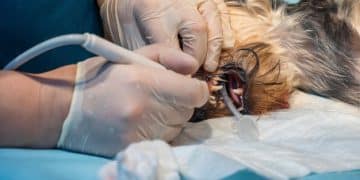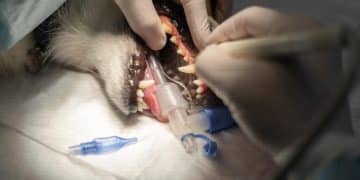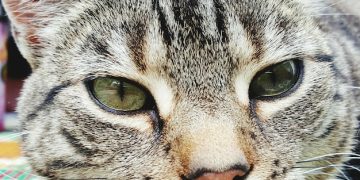5 Essential Grooming Tips for a Matt-Free, Happy Long-Haired Cat
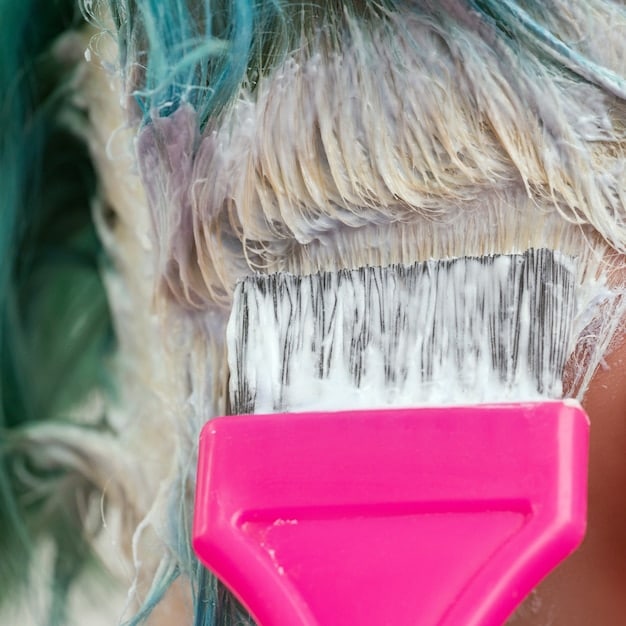
Keeping a long-haired cat matt-free and comfortable involves regular brushing, proper diet, occasional baths, professional grooming assistance, and creating a stress-free environment to ensure their coat stays healthy and their mood stays happy.
Does your long-haired feline friend struggle with mats? Discover 5 Essential Grooming Tips to Keep Your Long-Haired Cat Matt-Free and Comfortable, ensuring a healthy and happy cat.
Understanding the Grooming Needs of Long-Haired Cats
Long-haired cats are beautiful creatures, but their luxurious coats require dedicated care. Understanding the unique grooming needs of these felines is the first step in maintaining their coat’s health and preventing painful matting. Without proper grooming, long hair can quickly become tangled, leading to discomfort, skin issues, and even infections.
Why Long-Haired Cats Need More Grooming
Long-haired cats possess a distinct set of grooming requirements when compared to their short-haired counterparts. The length and density of their fur make them more susceptible to matting and tangles. Regular grooming is necessary to prevent these issues and keep their coat in top condition.
Potential Problems of Neglecting Grooming
Ignoring the grooming needs of a long-haired cat can lead to a variety of problems, ranging from minor discomfort to serious health issues. Matted fur pulls on the skin, causing pain and irritation. In severe cases, it can restrict movement and lead to skin infections.
- Mats can trap moisture and debris, leading to skin irritation and infections.
- Severe matting can restrict a cat’s movement and cause pain.
- Neglected coats can become infested with parasites like fleas and ticks.
Understanding the specific grooming needs of long-haired cats and the potential consequences of neglecting their coat is vital for any cat owner. Regular grooming is not just about aesthetics; it’s about ensuring the health and well-being of your feline companion.
Essential Tool #1: The Right Brushes and Combs
Choosing the right grooming tools is essential for maintaining your long-haired cat’s coat. A variety of brushes and combs are available, each designed for specific purposes. Using the appropriate tools will make grooming more effective and comfortable for your cat.
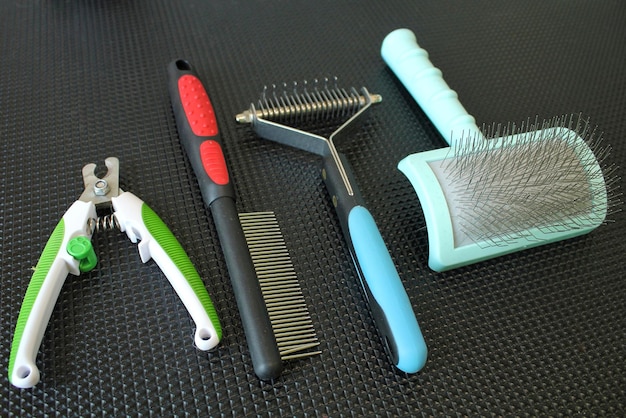
Types of Brushes
Selecting the right brush can make the grooming process more efficient and pleasant for your cat. Different types of brushes serve different purposes:
- Slicker Brush: Ideal for removing loose hair and detangling minor mats.
- Bristle Brush: Great for smoothing the coat and distributing natural oils.
- Undercoat Rake: Designed to reach deep into the coat and remove loose undercoat.
Choosing the Right Comb
Combs are essential for detecting and removing small tangles and mats. A metal comb with both wide and fine-toothed sides is an excellent choice for long-haired cats.
Investing in the right grooming tools is a crucial step in keeping your long-haired cat’s coat healthy and mat-free. Experiment with different brushes and combs to find the ones that work best for your cat’s coat type and grooming preferences. Make sure to introduce the tools in a positive way, pairing them with treats and praise to create a positive association.
Essential Tool #2: Developing a Regular Grooming Routine
Consistency is key when it comes to grooming a long-haired cat. Developing a regular grooming routine will not only keep their coat in good condition but also strengthen the bond between you and your feline friend.
Start Grooming Early
Introducing grooming from a young age helps cats become accustomed to the process. Kittens are more adaptable and likely to accept grooming as a normal part of their routine.
Daily Brushing
Daily brushing is essential for long-haired cats. A few minutes each day can prevent mats from forming and remove loose hair before it becomes tangled.
- Make grooming a positive experience by offering treats and praise.
- Choose a quiet time when your cat is relaxed and receptive to grooming.
- Be gentle and avoid pulling on tangled fur.
Establishing a regular grooming routine is essential for maintaining the health and appearance of your long-haired cat’s coat. Consistency, patience, and positive reinforcement will make grooming a pleasant experience for both you and your feline companion. Remember that every cat is different, so it may take some time to find a routine that works best for your cat’s unique needs.
Essential Tip #3: Bathing Your Long-Haired Cat
While cats are known for their self-grooming abilities, long-haired cats occasionally require a bath to remove dirt, grease, and loose hair. Knowing how to properly bathe your cat can make the process stress-free and effective.
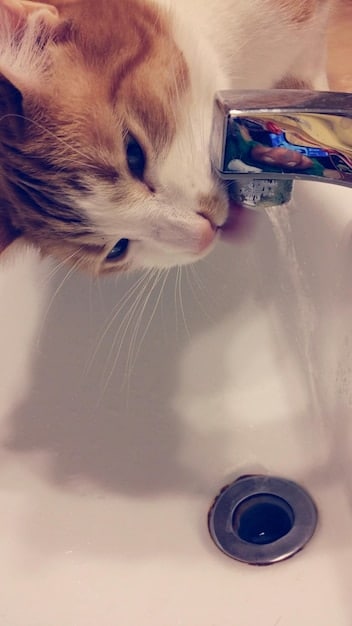
When to Bathe Your Cat
Bathing should not be a regular event unless your cat gets particularly dirty. Over-bathing can strip the coat of its natural oils, leading to dryness and skin irritation. Signs your cat may need a bath include:
- A greasy or dirty coat.
- An unpleasant odor.
- Visible dirt or debris in the fur.
Step-by-Step Bathing Instructions
Preparing for the bath is crucial to ensure a smooth process. Gather all necessary supplies, including:
- Cat-specific shampoo.
- Several towels.
- A non-slip mat for the sink or tub.
- A pitcher or cup for rinsing.
Bathing your long-haired cat can be a rewarding experience when done correctly. By preparing properly, using gentle techniques, and offering positive reinforcement, you can make bath time a stress-free event for both you and your feline companion. Remember to always use cat-specific products and be mindful of your cat’s comfort throughout the process.
Essential Tip #4: Diet and Hydration for Coat Health
A healthy coat starts from the inside out. Proper diet and hydration play a significant role in maintaining the health and appearance of your long-haired cat’s fur.
The Role of Diet
A balanced diet rich in essential nutrients is crucial for a healthy coat. Look for cat foods that contain:
- Omega-3 and omega-6 fatty acids
- High-quality protein
- Vitamins and minerals
Hydration is Key
Adequate hydration is essential for overall health and coat quality. Dehydration can lead to dry, brittle fur that is more prone to matting.
- Ensure your cat always has access to fresh, clean water.
- Consider adding wet food to your cat’s diet to increase their water intake.
- Use a water fountain to encourage drinking.
Nutrition and hydration are fundamental to maintaining a healthy and beautiful coat for your long-haired cat. By providing a balanced diet, ensuring adequate hydration, and consulting with your veterinarian when needed, you can support your cat’s overall health and keep their coat looking its best.
Essential Tip #5: Dealing with Existing Mats and Tangles
Even with the best grooming efforts, mats and tangles can still occur. Knowing how to safely and effectively remove them is essential for your cat’s comfort and well-being.
Safe Mat Removal Techniques
Trying to pull or cut out mats can be painful and dangerous for your cat. Instead, try these safe removal techniques:
- Use a mat splitter or de-matting comb to gently break up the mat.
- Apply a detangling spray to lubricate the fur and make it easier to comb through.
- Work slowly and patiently, taking breaks as needed.
When to Seek Professional Help
In some cases, mats may be too severe or close to the skin to remove safely at home. If you are uncomfortable removing the mats yourself or if your cat is in distress, seek professional help from a groomer or veterinarian.
Addressing mats and tangles promptly and safely is crucial for maintaining your long-haired cat’s comfort and health. By using the right tools and techniques, and knowing when to seek professional help, you can keep your cat’s coat matt-free and beautiful.
| Key Point | Brief Description |
|---|---|
| 🐱 Regular Brushing | Daily brushing prevents mats and removes loose hair. |
| 🛁 Occasional Baths | Bathe when necessary to remove dirt and grease. |
| 🍎 Proper Diet | A balanced diet supports coat health from within. |
| ✂️ Professional Help | Seek groomer or vet assistance for severe mats. |
Frequently Asked Questions
▼
Daily brushing is ideal for long-haired cats to prevent matting and remove loose hair. Even a few minutes each day can make a significant difference in maintaining their coat’s health and appearance.
▼
A combination of brushes works well. A slicker brush for detangling, a bristle brush for smoothing, and an undercoat rake for removing loose undercoat are all excellent choices for long-haired cats.
▼
Long-haired cats generally only need to be bathed when they are visibly dirty or have an unpleasant odor. Over-bathing can dry out their skin. Typically, bathing every few months is sufficient.
▼
Regular brushing is the best way to prevent mats. Also, ensure your cat has a healthy diet and stays hydrated. Addressing tangles as soon as you notice them can also prevent them from turning into mats.
▼
For large or difficult mats, it’s best to seek professional help from a groomer or veterinarian. Trying to remove large mats yourself can be painful for your cat. A professional can safely remove the mat without causing distress.
Conclusion
By implementing these grooming tips into your routine, you can ensure your long-haired cat stays comfortable, healthy, and matt-free. Regular care and attention to their coat will contribute to their overall well-being and strengthen the bond between you and your feline companion.

